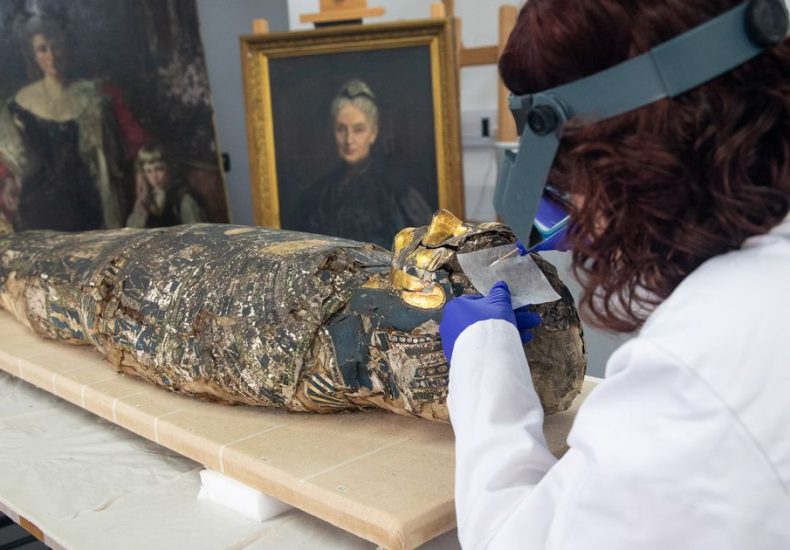
2,300-year-old Egyptian mummy undergoing vital treatment at University of Lincoln
A mummified Egyptian is being repaired and preserved at the University of Lincoln as part of a conservation project. Known as Pa-Sheri, the mummified man lived around 300 BCE during Egypt’s Ptolemaic period. He has been part of the museum collection at Derby Museums since at least 1859, and was sent to the university for much-needed work. The mummified man has intricately painted cartonnage and a gilded mask, which suggests a high social standing in ancient Luxor. During the 19th century it was common for mummified people brought to Britain to be unwrapped and ‘examined’. This appears to be what happened to Pa-Sheri, as his head, pelvis and parts of his limbs have been removed, and his arm bones have been rearranged into his chest cavity. As the outer wrappings were then reattached, the invasive treatment was concealed until the museum undertook X-rays of the 2,300-year-old-man. Conservation of Cultural Heritage students Ella Maude and Ella Monteiro are now helping to preserve both Pa-Sheri and his complex history with guidance from senior technician Josephine Mackenzie.
Pa Sheri’s gilded mask
(Image: University of Lincoln)
This is part of a conservation project funded by the Pilgrim Trust. Instead of restoring Pa-Sheri to an imagined original state, the team is taking a minimal intervention approach, stabilising areas of damage while preserving the evidence of his unusual post-mortem journey. This will include consolidating the flaking plaster and paint layers, cleaning the fragile surfaces using gentle techniques, and replacing the aged supports beneath Pa-Sheri’s mask with more durable materials. Ella said: “Working on Pa-Sheri has been a very personal and humbling experience. “His journey has been long and to conserve him is to become a part of his story. The work we are doing with Derby Museums ensures his legacy lives on and his story continues to be shared with the world.” She added: “This project has been an incredible learning experience. Our aim has been to protect him as he is now, respecting both his original context and the history that has followed. Despite his removal from his original burial place, I hope that our work helps to safeguard Pa-Sheri’s continued afterlife.” The project is also shedding light on ancient craftsmanship and Victorian-era interference. The team has identified vibrant pigments like Egyptian Blue, orpiment yellow, and both red and yellow ochres through polarised light microscopy, and UV light analysis has revealed the use of animal glue used during the 19th-century reassembly.
Detail on Pa Sheri’s cartonnage
(Image: University of Lincoln)
Josephine Mackenzie, senior conservation technician at Lincoln, said: “This project has offered the students a unique opportunity to engage with a complex conservation challenge. Pa-Sheri represents a rare case study, illuminating not only the materials and techniques of his period but also the evolving history of collecting and conservation practices. “Our responsibility is to preserve him with the highest level of respect, acknowledging both his original cultural context and the ways in which his story has been reframed over subsequent centuries. By adopting a careful, minimal-intervention approach, we safeguard the object’s integrity while retaining the evidence of its lengthy historical journey. “It is gratifying to know that this work will directly inform the museum’s forthcoming exhibition and enhance public understanding.” After the conservation, Pa-Sheri will return to Derby Museums and will be displayed alongside another mummified individual. Laura Phillips, head of curatorship at Derby Museums said: “It has been a pleasure continuing our long-term partnership with the team and students at Lincoln. Arranging the appropriate care for Pa-Sheri is a challenge and whilst this essential conservation takes place, we know he is in safe and caring hands. “Derby Museums promotes skill sharing and career development opportunities whenever possible and is committed to supporting students to engage with our collections through partnerships like this.”
You may also like
You may be interested
German Shepherd in Lincolnshire searching for forever home after spending more than a year in RSPCA care
A German Shepherd is searching for its forever home after...
Too big and in the wrong place – council’s verdict on major solar farm
Lincolnshire County Council has told the government that a proposed...
Skegness police officer given final written warning over ‘unnecessary’ use of spray on suspect
A Skegness police officer has been given a final written...



Leave a Reply